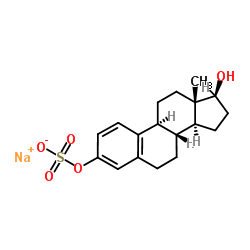Sulfotransferase 2A1 forms estradiol-17-sulfate and celecoxib switches the dominant product from estradiol-3-sulfate to estradiol-17-sulfate.
Li-Quan Wang, Margaret O James
文献索引:J. Steroid Biochem. Mol. Biol. 96(5) , 367-74, (2005)
全文:HTML全文
摘要
Using recombinant sulfotransferases (SULTs) expressed in E. coli, beta-estradiol (E2) sulfonation was examined to determine which SULT enzyme is responsible for producing E2-17-sulfate (E2-17-S). SULTs 1A1*1, 1A1*2, 1A3, 1E1 and 2A1 all sulfated E2 to varying extents. No activity was observed with SULT1B1. Among the SULTs studied, SULT2A1 produced primarily E2-3-sulfate (E2-3-S), but also some E2-17-S and trace amounts of E2 disulfate. SULT2A1 had a K(m) value of 1.52 microM for formation of E2-3-S and 2.95 microM for formation of E2-17-S. SULT2A1 had the highest V(max) of 493 pmol/min/mg protein for formation of E2-3-S, which was 8.8- and 47-fold higher than the maximal rates of formation of E2-17-S and E2 disulfate, respectively. SULT2A1 formed E2-3-S more efficiently. However, when celecoxib (0-160 microM) was included in the incubation with either SULT2A1 or human liver cytosol, sulfonation switched from E2-3-S to E2-17-S in a concentration-dependent manner. The ratio of E2-17-S/E2-3-S went up to 15 with SULT2A1, and was saturated at 1 with human liver cytosol. In both cases, more E2-17-S was formed, with the unreacted E2 remained unchanged, suggesting celecoxib probably bound to a separate effector site to cause a conformational change in SULT2A1, which favored production of E2-17-S. The ability of celecoxib to alter the position of sulfonation of E2 may in part explain its success in the experimental prevention and treatment of breast cancer.
相关化合物
| 结构式 | 名称/CAS号 | 分子式 | 全部文献 |
|---|---|---|---|
 |
BETA-雌二醇 3-硫酸钠盐
CAS:4999-79-5 |
C18H23NaO5S |
|
Steroid sulphate secretion by the human ovary in vitro: infl...
1980-12-01 [J. Steroid Biochem. 13(12) , 1401-6, (1980)] |
|
[Evidence, in vitro, of estrone and estradiol-17 beta 3-sulf...
1981-03-02 [C. R. Seances. Acad. Sci. III. 292(9) , 609-12, (1981)] |
|
Genomics of estradiol-3-sulfate action in the ovine fetal hy...
2012-07-03 [Physiol. Genomics 44(13) , 669-77, (2012)] |
|
Fetal hypothalamus-pituitary-adrenal responses to estradiol ...
2011-12-01 [Endocrinology 152(12) , 4966-73, (2011)] |
|
The in vitro metabolism of estrone and estradiol-17 beta and...
1981-12-01 [J. Steroid Biochem. 15 , 453-9, (1981)] |